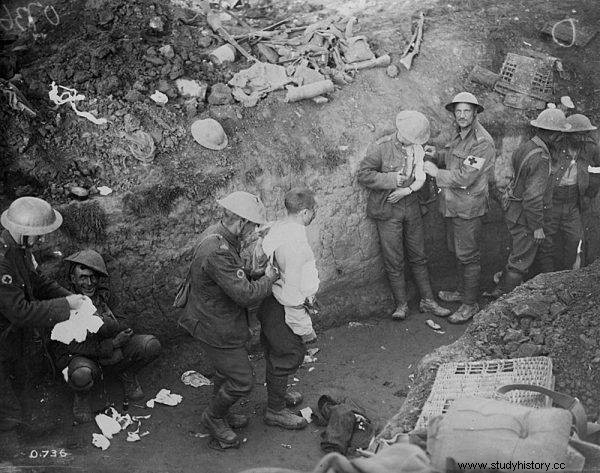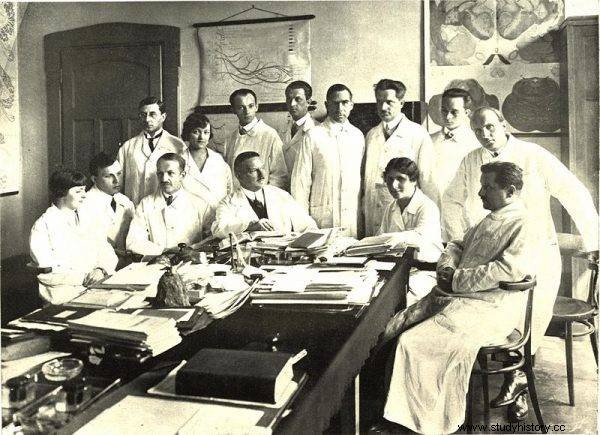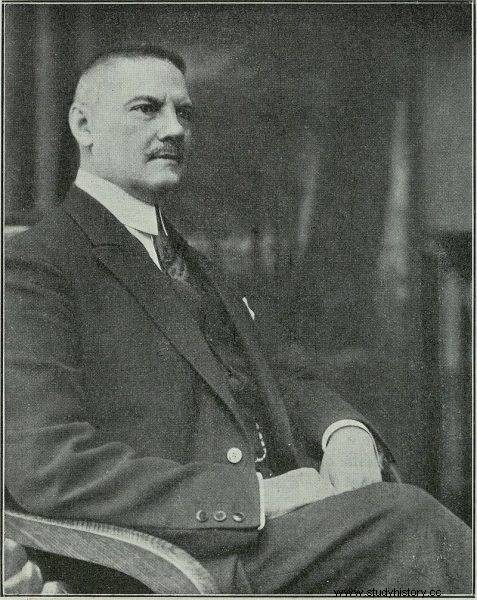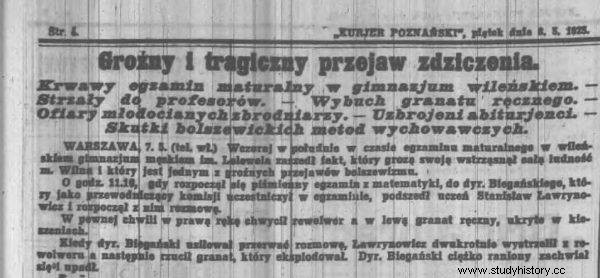After the end of the war with the Bolsheviks, research into post-traumatic stress disorder practically did not exist in Poland. Only professor Jan Piltz led them. After his death, no one looked at the mental health of the soldiers.
Nervous disorders caused by combat stress were first described during the American Civil War. Then the doctor Jacob Da Costa noticed that soldiers who had been in battle for a long time had shortness of breath, palpitations and a sharp, burning pain in the chest j. Da Costa called it Irritable Heart Syndrome.
More detailed research appeared only during the First World War. Although the command initially considered such soldiers to be cowards and roofers, by the end of 1914 about 10 percent of the officers and 4 percent of the privates of the British army showed signs of nervous disorder. Altogether, it is tens of thousands of military personnel!
The term "artillery shock" was first used by British psychiatrist Charles Myers in 1915, referring to soldiers who needed to flee the battlefield under enemy fire.
Panic anxiety was often accompanied by symptoms the causes of which were not fully understood. The soldiers temporarily lost their eyesight, hearing, memory, convulsions, and were unable to stand. Psychiatrists from all sides of the conflict have started researching and treating trauma soldiers.
Krakow school and its observations
In 1917 in Kobierzyn, the construction of a hospital called the National Institute for the Mentally Sick was completed. Professor Jan Piltz, who heads the Department of Neurology and Psychiatry of the Jagiellonian University, developed an original method of treating peripheral neurosis.
After arriving at the clinic in Krakow, the patient was subjected to several days of observation, during which not only the examination was carried out, but also hereditary factors were determined. The study was preceded by an interview consisting of two parts. The first:the patient's entire life from childhood to the onset of the disease, and the second:the emergence and course of the current disease.

By the end of 1914, about 10 percent of the British Army's officers and 4 percent of the privates showed signs of a nervous disorder. Altogether, it is tens of thousands of military personnel!
The scientist emphasized:
The most effective and most important method of treatment (...) is psychotherapy. It consists primarily in calming the patient, gaining his trust, awakening his confidence in his own strength, strengthening his willpower, dissolving and alleviating his pathological affective state, correcting his pathological mental connections and removing his pathological self-suggestions.
The treatment results were very promising. They continued, albeit to a lesser extent, during the war with the Bolsheviks.
Read also:They were electrocuted, starved and shot. Frontal neurosis (post-traumatic stress disorder) in the First World War
White Spot
Today it is in vain to look for medical studies on post-traumatic stress during the war with the Bolsheviks. There was not a word on this subject in the manuals and textbooks of combat medicine at the time. The military considered the most important care for the wounded in the field and prevention against venereal diseases.
Only in the work "Urgent social tasks in the field of neurology and psychiatry" by prof. Piltz, in addition to "combating masturbation among young people" and "introducing the statutory obligation of paid holidays", postulated "rational care for mentally and neurotic war invalids", as well as "the creation of a special facility for traumatic neuroses."

Professor Jan Piltz, who heads the Department of Neurology and Psychiatry of the Jagiellonian University, developed an original method of treating peripheral neurosis.
Piltz believed that doctors should carefully screen and screen out cases of traumatic neurosis because experience from the great war has shown that they are "98% curable and that healing can be achieved even in a relatively short time , within 1 to 6 weeks ”. However, the suggestions were not implemented in most cases. And the neurosis was taking its toll.
Suicide streak
There are no detailed reports of suicides related to the war experiences. Such statistics were not kept. Single cases can be found in the memories of veterans.
One of them happened in Murmansk, just before the Murmansk battalion returned to Poland.
The next day (24.I.) at At 5 am we had a bad accident, because one of our companions, Sergeant August Surowiecki, cut his throat with a razor because of a nervous disorder . Taken from the ship by motorboat to the hospital in Murmansk, he died there 5 days later and was buried on 31.I. in this town, and on its tombstone cross, arranged by Cpt. Bogusław Szul-Skjöldkron, the inscription "From the equator to the pole, there is a Polish legend everywhere".

Piltz believed that doctors should carefully screen and screen out cases of traumatic neurosis because experience from the Great War has shown that they are "98% curable".
"Robotnik" of February 15, 1920 reported the suicide of Private Mayzner, who shot himself with a rifle. Just two weeks later, the same newspaper reported on the suicide of Corporal Stanisław Ożarowski from the 1st Regiment of Light Cavalry. In this case, there were also harassments from the superiors. In July, a cadet committed suicide due to a nervous disorder. Kazimierz Cukierwar from the 1st Intelligence Squadron. There were quite a few such events.
The most famous one happened a few years after the end of the war. It was an extended suicide in which five people were killed.
Read also:The number of victims of the First World War. How many people died in the Great War?
Bloody shootout in middle school
On May 6, 1925, the matura exams continued. At 11:05 am Stanisław Ławrynowicz, a student of the Joachim Lelewel in Vilnius drew his pistol and fired two shots at the headmaster of the school, Edward Biegański. It hit his shoulder. The students sitting next to them tried to incapacitate the shooter. They grabbed his hands. Lavrynowicz dropped his weapon. He broke free and pulled a hand grenade from his pocket. He pulled the pin and tossed it forward.
As a result of the explosion, Ławrynowicz and two students struggling with him - Tadeusz Domański and Aleksander Zahorski - died on the spot. Apart from director Bieganski, the students of Bończa-Osmołowski, Studziński, Borysewicz, Toczyłowski, Symonowicz, Wojtkiewicz, Nawrocki and Gliński were injured.

Information from the newspaper "Kurjer Poznański" about the massacre at the Lelewel school in Vilnius.
Seeing the death of his friend, Janusz Obrąpalski stood up, who pulled a revolver from his jacket and started shooting at the members of the examination committee . It hit the stomach of the physics teacher Jan Jankowski. Later he ran into the corridor and tried to use a grenade, but the damaged fuse did not work. So he picked up the gun, put it to his temple, and pulled the trigger.
At first, the press of the time thundered that it was "a menacing and tragic manifestation of savagery." Kurjer Poznański even wrote that "a fact took place which shocked the entire population of the city of Vilnius and which is one of the dangerous manifestations of Bolshevism". Some authors keep repeating this nonsense, adding that the reason may have been problems at school. The truth is quite different.
Both were participants in the war with the Bolsheviks. They both began to show signs of post-traumatic stress disorder upon their return. Both caused problems and lived on the verge of death, driving insane car rallies. With each passing year, the mental state of the veterans deteriorated - they felt alienated. Nobody provided them with medical care.
Forgotten patients
There were basically no examinations and convalescence at that time. As early as two years after the end of the war, the interest in post-traumatic stress ceased in a systemic way. Patients were treated only in Kobierzyn near Kraków and in Lviv, where prof. Piltz, Eugeniusz Artwiński.
Professor Piltz died in 1930 as a result of postoperative complications. Artwiński died 14 years later of chronic heart disease. Nobody remembered about their former patients.
